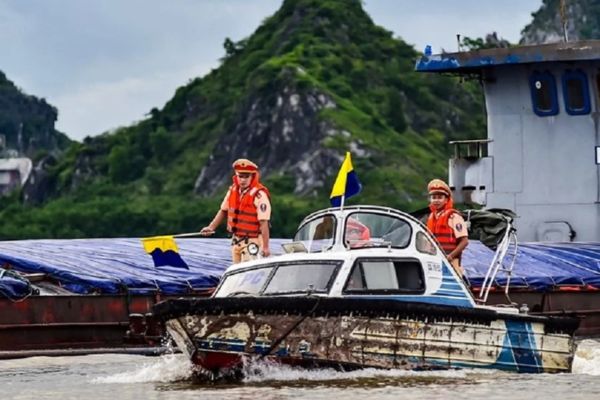Can Waterway Police Temporarily Retain the Documents of Violators? If So, Which Documents Can Be Temporarily Retained?
Can the Waterway Police temporarily seize the documents of violators? If so, which documents may be seized?
According to point d, clause 2, Article 11 of Circular 36/2023/TT-BCA, the Waterway Police may temporarily seize the following documents of traffic violators, in the following order:
- Certificate of shipmaster's professional competence,- Vehicle operator's certificate- Vehicle registration certificate or valid confirmation from a credit institution in cases where the vehicle is mortgaged- Vehicle's technical safety and environmental protection certificate- Certificate of chief engineer's professional competence- Other documents related to the exhibits and means as prescribed by law.
The temporary seizure of one of the above documents is to ensure compliance with the decisions on administrative penalty enforcement.
If the violator does not have the aforementioned documents, the administrative violation vehicle may be temporarily seized to ensure the enforcement of the decision on administrative penalties.

Can the Waterway Police temporarily seize the documents of violators? If so, which documents may be seized? (Image from the Internet)
What are the procedures for handling administrative violations in waterway traffic without making a record?
According to clause 1, Article 10 of Circular 36/2023/TT-BCA, the procedures for handling administrative violations without making a record are as follows:
Handling violations during patrolling and controlling
1. Cases of handling administrative violations without making a record
When detecting acts of violation falling under the cases of handling without making a record, the person with the authority to handle must issue a decision on administrative penalty on the spot; if the individual or organization committing the violation has not immediately executed the penalty decision, they have the right to temporarily seize related documents in the order prescribed in point d, clause 2, Article 11 of this Circular to ensure compliance with the penalty decision.
...
In cases of handling administrative violations without making a record, the person with the authority to handle must issue a decision on administrative penalty on the spot; if the individual or organization committing the violation has not immediately executed the penalty decision, they have the right to temporarily seize related documents in the order prescribed in point d, clause 2, Article 11 of Circular 36/2023/TT-BCA to ensure compliance with the penalty decision.
What conditions must be met for the Waterway Traffic Police to stop a vehicle for inspection?
According to Article 8 of Circular 36/2023/TT-BCA, the conditions for stopping a waterway vehicle for inspection are regulated as follows:
Stopping vehicles for inspection
1. Officers conducting patrols and inspections as per the plan are authorized to stop vehicles for inspection in the following cases:
a) Directly detecting or through means, technical devices discovering and recording signs of legal violations;
b) Executing directives, patrolling plans, work plans approved by the Head of the Waterway Police Division; the Head of the Traffic Police Division; the Head of the District Police;
c) Having a written request to stop the vehicle from the Head or Deputy Head of the Investigation Authority at all levels, or related functional authorities for the purpose of national security protection, ensuring public order and safety;
d) Reports or accusations of legal violations related to individuals and vehicles participating in traffic.
2. Requirements when stopping vehicles for inspection
a) Safety, compliance with the law, not obstructing traffic activities. Once the vehicle is stopped, the inspection must be conducted, and violations handled (if any) according to legal regulations;
b) Choosing a control location with a significant depth and width channel, open space, and good visibility; ensuring the stoppage and inspection of the vehicle to be public and transparent;
c) In cases of stopping and inspecting vehicles transporting flammable, explosive substances, toxic substances, or other dangerous goods, besides meeting the requirements at points a and b of this clause, there must be safety measures to guide the vehicle away from residential areas or sparsely populated places before stopping for inspection.
...
According to the above regulations, officers conducting patrols and inspections as per the plan are authorized to stop vehicles for inspection in the following cases:
- Directly detecting or through means, technical devices discovering and recording signs of legal violations.- Executing directives, patrolling plans, work plans approved by the Head of the Waterway Police Division; the Head of the Traffic Police Division; the Head of the District Police.- Having a written request to stop the vehicle from the Head or Deputy Head of the Investigation Authority at all levels, or related functional authorities for the purpose of national security protection, ensuring public order and safety.- Reports or accusations of legal violations related to individuals and vehicles participating in traffic.
In addition, clause 2 of Article 8 of Circular 36/2023/TT-BCA regulates the requirements when stopping vehicles for inspection as follows:
- Safety, compliance with the law, not obstructing traffic activities. Once the vehicle is stopped, the inspection must be conducted, and violations handled (if any) according to legal regulations.- Choosing a control location with a significant depth and width channel, open space, and good visibility; ensuring the stoppage and inspection of the vehicle to be public and transparent.- In cases of stopping and inspecting vehicles transporting flammable, explosive substances, toxic substances, or other dangerous goods, besides meeting the requirements at points a and b of this clause, there must be safety measures to guide the vehicle away from residential areas or sparsely populated places before stopping for inspection.
LawNet